Success -- At Last !
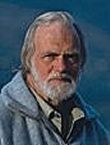 "Patience
is a virtue." "Patience
is a virtue."
"All good things come to him that waits."
"The patience of Job."
I am very familiar with these old maxims, and their advice is good, but
I still think that having to wait for 58 years is a bit much. For what did
I have to wait 58 years? Therein lies the tale I'm about to tell you.
It was in the spring of 1945. I had just purchased my first Alpa 35mm
through-the-lens camera. Because of Art Wilkins and the photographs he had
taken of my fox pelts, I had purchased a Kodak 35mm camera the year
before. Within just a few months I knew that this camera, with a fixed
lens, would never do the job for me. Wildlife photography usually requires
the longest lenses possible and that's why I had chosen an Alpa 35mm
camera with a 500mm lens. And it was because of Art Wilkins that I was now
sitting along the bank of the Delaware River on May 19th getting a crick
in my neck from staring up at a cavity about sixty feet above the ground
in a huge sycamore tree.
Art and I were good friends and we trapped together for muskrats in the
winter. His home was on the Delaware's riverbank and the sycamore was in
his backyard. For the past couple of years, Art had watched a female wood
duck fly in and out of the cavity where she had her nest. The male would
sometimes perch on a nearby tree limb while the female slipped into the
cavity to lay an egg. At other times, while the female flew into the
hollow, the male would just fly right on by. Art could usually tell when
the female started to incubate the eggs because, when she did so, the male
stopped coming in. The incubation period for wood ducks is 28 to 30 days
and the female usually keeps the young in the nest for at least one more
days to make sure that all the eggs that are going to hatch have a chance
to do so.
Knowing the above, we had calculated from the last day that Art had
seen the male, that TODAY was the day the little wood ducks should leave
the nest. You would think that a sixty foot fall would kill the young
ducklings, but folks who have witnessed it have stated that they just
bounce when hitting the ground, evidently none the worse for their drop to
the ground. You noticed I said "folks who have witnessed it,"
because I didn't. The only thing I did get that morning was the crick in
my neck about which I already told you. Either the ducks had left the day
before, or perhaps they left the following day, but I saw absolutely no
sign of a duck that morning. And that morning was the only time I could
spare. I was working on the family farm back in 1946 and really didn't
have the time to be watching for ducks.
In 1970, I had a ¾ acre pond built on the property on which I now
live. To encourage the wood ducks to use my pond, I put up eight wooden
nest boxes for them. Some have rotted apart over the years and I have
added additional boxes. Today I have ten boxes up with two more in need of repair. Over the years, the ducks have used five boxes at the
most and usually just three. Although nest boxes are needed by the wood
ducks, what really attracts them to my pond is the bucket of corn that I
have put out, or had put out, every day since the pond was built. Even in
the winter, when the wood ducks have gone, I throw corn out on the ice
because the mallards come in year round. No critter, including us humans,
can pass up a free meal.
Writing this column has made me curious. Over the
course of the last 34 years, or approximately 12,410 days, I have put out
a lot of corn for those ducks. On average, I feed about eight quarts per
day and I just went out and weighed that amount of corn; it weighs a
little over twelve pounds. That's 148,720 pounds of corn, or 75 tons, over
a 34 year period, or roughly two tons per year. I'm paying nine dollars a
hundred pounds for shelled corn now so it cost me roughly a dollar a day
or $12,410 to feed those ducks over the years. Has it been worth it? You
bet it has! I'm just thrilled to see the ducks circling over the pond. I
love watching them set their wings and splash down. The prismatic
iridescent beauty of the wood ducks is beyond my ability to describe. I
have been rewarded with photography that is beyond calculation. They are
my version of Chartres' stained glass windows floating on my pond.
Over the years, I have tried to photograph the baby wood ducks jumping
out of the nest boxes. My biggest problem is that I'm usually gone on a
trip somewhere at about the time the ducklings hatch. About five years
ago, my wife and I were ready to leave on an extended trip and had the car
and trailer loaded to go early in the morning. I carried the corn down to
the pond and noticed a female wood sitting on the top of a box, her head
bent down near the opening, calling. I realized that she was trying to
call the young from the box. I threw the corn in the pond, dashed up and
told my wife that we couldn't leave right then as I wanted to try for the
ducks. Grabbing a camera and a blind, I set it up. Of course the duck had
flown off when she first saw me come down to the pond. Noting the new
blind as she flew over the area, she just would not come back. I sat in
the blind until noon with no luck, and then admitted defeat, packed up my
gear and left on our trip.
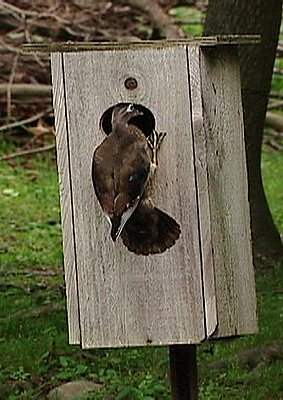 This year, 2004, we had no trip planned and I was determined to try for
the ducks again. Three boxes were being used, but I did not want to
disturb the ducks to see when the ducklings hatched. However, a duck
always flew out of one of the boxes when I threw the corn in the water. I
knew that some ducklings from other boxes were already out because I had
seen them. The females do not keep their ducklings on my pond as there is
not enough emergent vegetation for them to hide in, the deer have eaten
it. So as soon as the ducklings are out of the box, the females take them
down to a nearby swamp where cover is plentiful. This year, 2004, we had no trip planned and I was determined to try for
the ducks again. Three boxes were being used, but I did not want to
disturb the ducks to see when the ducklings hatched. However, a duck
always flew out of one of the boxes when I threw the corn in the water. I
knew that some ducklings from other boxes were already out because I had
seen them. The females do not keep their ducklings on my pond as there is
not enough emergent vegetation for them to hide in, the deer have eaten
it. So as soon as the ducklings are out of the box, the females take them
down to a nearby swamp where cover is plentiful.
When the duck flew out of the box one Saturday morning, I got my camera
and got into my permanent blind. After about an hour, a female wood duck
flew up on the box and craned her neck down to the hole. When she did, I
saw what appeared to be a duckling's head pop into view and then
disappear. I was elated! Perhaps this time I was finally going to get the
ducklings coming out.
The day was hot, and sitting in the metal blind, I was sweltering. I
took off my shirt, I took off my shoes and socks, I rolled up the legs of
my jeans above the knee-- and still the sweat poured off. At 11:30 the
ducklings still hadn't come out. I called my wife on our two-way radio and
asked that she eat her lunch and then come take my place while I ate and
had my nap, and that's what we did. At 1:30 I was back in the blind until
supper time when my wife again kept watch while I ate. Then it was in the
blind again for me until dark. Nothing. When I got my gear up to the house
I popped the cassette out of my camera and put it in my video deck. I just
had to see what I thought I had seen in the morning. I really had seen
something, but it was another female duck's bill and not ducklings. The
brooding female was defending her nest against the other hen, trying to
dump an egg in the box. In the more than twelve hours my wife and I had
been in the blind, we had gotten video of other woodies, mallards and
geese, but not ducklings.
Right then and there I vowed that each morning I'd wear my hip boots
when I fed the ducks, and when the female flew out, I'd open the box to
see if her eggs had hatched. This I did, day after day, for over two weeks
until one morning when I went down to feed the ducks their daily allotment
of corn, the female did not fly out of the box when the corn hit the
water. I looked inside, No ducklings, just eggs. I told my wife that I
thought the duck had abandoned the nest; the eggs must have been
infertile.
The next morning when I threw the corn in the water, the hen jumped out
and swam away. She had never done that before, she had always flown out
and away. I hadn't worn my hip boots that day because I was sure the nest
had been abandoned, but it hadn't been. Getting my boots, I waded out,
lifted the lid on the box and peered in -- on a boxful of black fluffy
ducklings.
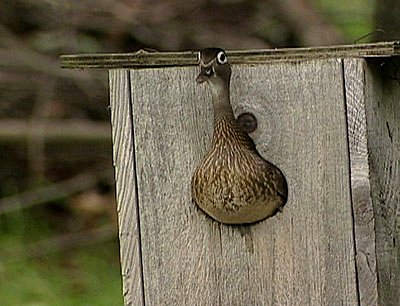 Five minutes later I had my camera set up in my blind and ten minutes
after that the hen flew into the box, only to reappear about five minutes
later. This time, however, she sat in the opening and extended her neck as
high as possible to allow her to see behind the box. Five minutes later I had my camera set up in my blind and ten minutes
after that the hen flew into the box, only to reappear about five minutes
later. This time, however, she sat in the opening and extended her neck as
high as possible to allow her to see behind the box.
She looked and she
listened. She was in no hurry; she wanted to be sure that no danger lurked
nearby. Then she flew down to the water and gave a short "come
out" call I had never heard before.
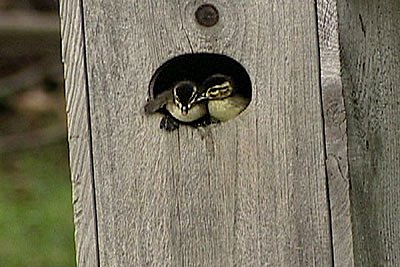 Like popcorn spilling out of the
popper hopper, the little balls of fluff clambered up the inside of the
box and, without even saying "Geronimo," barreled out into the
water below. The female kept calling until she had all thirteen ducklings
out of the box. As soon as the ducklings hit the water, they started to
feed on tiny water insects, and one climbed up on its mother's back. When,
in response to her calling, the female heard no answering call from the
box, she gathered her brood together and convoyed them across the pond,
climbed up over the bank and they were gone to the nearby swamp. Like popcorn spilling out of the
popper hopper, the little balls of fluff clambered up the inside of the
box and, without even saying "Geronimo," barreled out into the
water below. The female kept calling until she had all thirteen ducklings
out of the box. As soon as the ducklings hit the water, they started to
feed on tiny water insects, and one climbed up on its mother's back. When,
in response to her calling, the female heard no answering call from the
box, she gathered her brood together and convoyed them across the pond,
climbed up over the bank and they were gone to the nearby swamp.
It has taken me 58 years and over $12,000 to get video footage and
photos of a
sight I had never seen, that most folks will never see. Now I want to get
my video footage out so I can share it with the whole world. These
pictures are to give you folks a sneak preview of one of my greatest
personal moments witnessing nature.
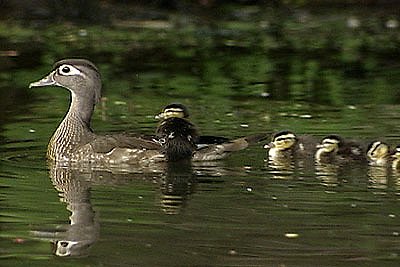 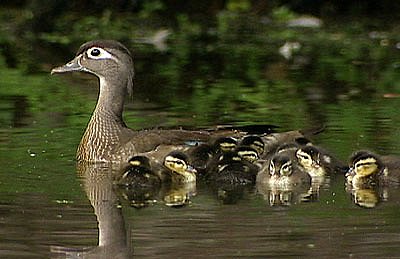
| Unique
Opportunity for Deer Photography 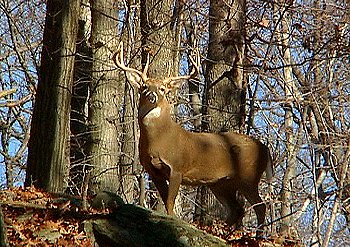 T T
wenty
years ago I started my own deer herd so I could research and
record the life of the deer on a day to day basis. It has allowed
me to study and photograph every aspect of the lives of these
truly magnificent animals. I have written seven books on
deer.
The high protein food I feed them,
as well as the bucks’ age and genetics, produce Boone &
Crockett point class antlers.
For the first time, I am opening my
private, fenced-in preserve for still photography only, for a
period of five weeks starting September 18th, through October
23rd. I will be with you throughout the photo session to answer
questions and offer advice on how to best capture images of these
wonderful animals.
The 14 acre fenced-in terrain
includes a wooded hillside where most photography will be done,
and a forested, marshy area. This is a great photographic
opportunity! For additional information and photos please click
here.
For cost and information please
call,
fax or e-mail us at: 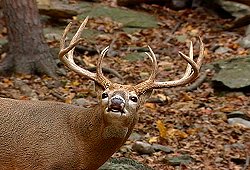
Leonard Lee Rue III
138 Millbrook
Road Blairstown
New Jersey
07825
Phone: 908-362-6616
Fax: 908-362-5808
email: sales@ruevideo.com
|
 Subscribe to
Vivid Light
Subscribe to
Vivid Light
Photography by email
Tell
Us What You Think
|

|
